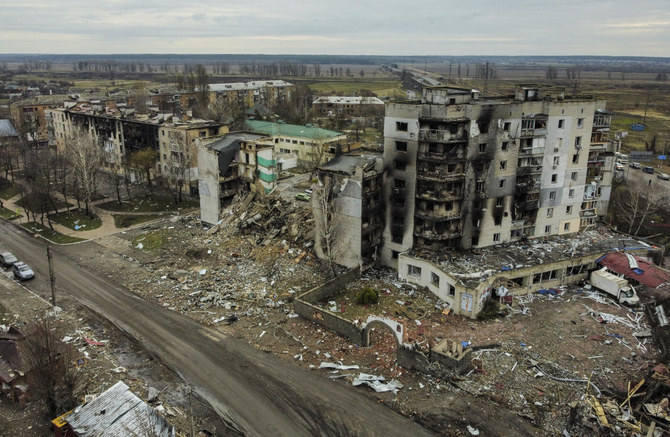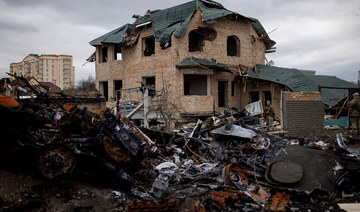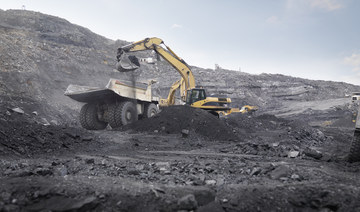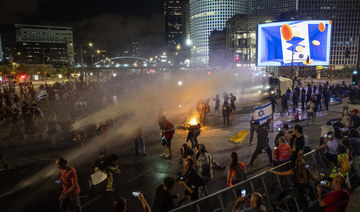KYIV: Ukraine was bracing to battle for control of its industrial east and appealing for more help from the West after Russian forces withdrew from the shattered outskirts of Kyiv to regroup.
Authorities were urging people to immediately evacuate from the Donbas region before Russia intensifies its offensive. In Brussels, Ukrainian Foreign Minister Dmytro Kuleba urged NATO to provide more weapons for his war-torn country to help prevent further atrocities like those reported in the city of Bucha.
“My agenda is very simple… it’s weapons, weapons and weapons,” Kuleba said as he arrived at NATO headquarters Thursday for talks with the military organization’s foreign ministers about Ukraine’s fight against Russia’s invasion.
“We know how to fight. We know how to win. But without sustainable and sufficient supplies requested by Ukraine, these wins will be accompanied by enormous sacrifices,” Kuleba said. “The more weapons we get and the sooner they arrive in Ukraine, the more human lives will be saved.”
NATO Secretary-General Jens Stoltenberg urged members to provide more weapons and not just defensive arms. Some NATO members worry that they may be Russia’s next target but the alliance is striving to avoid moves that might pull countries directly into the conflict.
“NATO is not sending troops to be on the ground. We also have a responsibility to prevent this conflict from escalating beyond Ukraine, and become even more deadly, even more dangerous and destructive,” Stoltenberg said.
A US defense official speaking on condition of anonymity said Russia had pulled all of its estimated 24,000 or more troops from the Kyiv and Chernihiv areas in the north, sending them into Belarus or Russia to resupply and reorganize, probably to return to fight in the east.
Growing numbers of Putin’s troops, along with mercenaries, have been reported moving into the Donbas. “Later, people will come under fire,” Ukrainian Deputy Prime Minister Iryna Vereshchuk said in urging civilians to evacuate from the mostly Russian-speaking industrial region, “and we won’t be able to do anything to help them.”
Ukrainian forces have been fighting Russia-backed separatists in the Donbas since 2014. Ahead of its Feb. 24 invasion, Moscow recognized the Luhansk and Donetsk regions as independent states.
Another Western official, also speaking on condition of anonymity to discuss intelligence estimates, said it may take Russia’s battle-damaged forces as much as a month to regroup for a major push on eastern Ukraine.
In his nightly address Wednesday, Ukrainian President Volodymyr Zelensky also warned Russia’s military is gearing up for a new offensive in the east.
Ukraine, too, was preparing for battle, he said.
“We will fight and we will not retreat,” he said. “We will seek all possible options to defend ourselves until Russia begins to seriously seek peace. This is our land. This is our future. And we won’t give them up.”
In areas north of the capital, Ukrainian officials were gathering evidence of Russian atrocities amid signs Moscow’s troops killed people indiscriminately before retreating.
Ukrainian authorities said the bodies of least 410 civilians were found in towns around Kyiv, victims of what Zelensky has portrayed as a Russian campaign of murder, rape, dismemberment and torture. Some victims had apparently been shot at close range. Some were found with their hands bound.
Zelensky accused Russia of interfering with an international investigation into possible war crimes by removing corpses and trying to hide other evidence in Bucha, northwest of Kyiv.
“We have information that the Russian troops have changed tactics and are trying to remove the dead people, the dead Ukrainians, from the streets and cellars of territory they occupied,” he said during his latest video address. “This is only an attempt to hide the evidence and nothing more.”
Switching from Ukrainian to Russian, Zelensky urged ordinary Russians “to somehow confront the Russian repressive machine” instead of being “equated with the Nazis for the rest of your life.”
He called on Russians to demand an end to the war, “if you have even a little shame about what the Russian military is doing in Ukraine.”
In reaction to the alleged atrocities outside Kyiv, the US announced sanctions against Putin’s two adult daughters and said it is toughening penalties against Russian banks. Britain banned investment in Russia and pledged to end its dependence on Russian coal and oil by the end of the year.
The US Senate planned to take up legislation Thursday to end normal trade relations with Russia, paving the way for higher tariffs on some imports, and to codify President Joe Biden’s executive action banning imports of Russian oil.
The European Union is also expected to take additional punitive measures, including an embargo on coal.
The Kremlin has insisted its troops have committed no war crimes and alleged the images out of Bucha were staged by the Ukrainians.
Bodies were still being collected in the city. On Wednesday, The Associated Press saw two in a house in a silent neighborhood. From time to time there was the muffled boom of workers clearing the town of mines and other unexploded ordnance.
Workers at a cemetery began to load more than 60 bodies into a grocery shipping truck for transport to a facility for further investigation.
Police said they found at least 20 bodies in the Makariv area west of Kyiv. In the village of Andriivka, residents said the Russians arrived in early March, taking locals’ phones and detaining and then releasing some people. Others met unknown fates. Some described sheltering for weeks in cellars normally used for storing vegetables.
“First we were scared, now we are hysterical,” said Valentyna Klymenko, 64. She said she, her husband and two neighbors weathered the siege by sleeping on stacks of potatoes covered with a mattress and blankets. “We didn’t cry at first. Now we are crying.”
In the southern port city of Mariupol, Mayor Vadym Boichenko said that of the more than 5,000 civilians killed during weeks of Russian bombardment and street fighting, 210 were children. Russian forces bombed hospitals, including one where 50 people burned to death, he said.
Boichenko said more than 90 percent of the city’s infrastructure was destroyed. The attacks on the strategic city on the Sea of Azov have cut off food, water, fuel and medicine and pulverized homes and businesses.
British defense officials said 160,000 people remained trapped in the city, which had a prewar population of 430,000. A humanitarian relief convoy accompanied by the Red Cross has been trying for days without success to get into the city.
Capturing Mariupol would allow Russia to secure a continuous land corridor to the Crimean Peninsula, which Moscow seized from Ukraine in 2014.
Ukraine seeks arms from NATO as fight looms on eastern front
https://arab.news/jjsvs
Ukraine seeks arms from NATO as fight looms on eastern front

- NATO Secretary-General Jens Stoltenberg urged members to provide more weapons and not just defensive arms
Ukraine to get up to 100,000 shells in June: Czech official
Ukrainian forces said earlier this year they were so low on supplies that they were forced to ration ammunition, letting Russia seize ground
PRAGUE: Ukraine will receive 50,000-100,000 shells in June under a Czech-led initiative to buy ammunition for the war-ravaged country largely outside Europe, a Czech official said Thursday.
Tomas Kopecny, the Czech government envoy for Ukraine reconstruction, told reporters that Ukraine, battling a Russian invasion since February 2022, could get millions of shells if allies managed to collect the money.
“The first delivery under the umbrella of this Czech initiative will be in June, and it will be dozens of thousands of shells, between 50 and 100,” he said on the fringes of a meeting of NATO foreign ministers in Prague.
Ukrainian forces said earlier this year they were so low on supplies that they were forced to ration ammunition, letting Russia seize ground.
Russia has more recently launched a widescale offensive in northeastern Ukraine ahead of the delivery of US weapons that were approved after a long delay in Congress.
Besides the Czech Republic, Canada, Denmark, Germany, the Netherlands and Portugal have so far contributed some 1.7 billion euros ($1.8 billion) to buy 500,000 shells in the first phase, Kopecny said.
Ten other countries are “in the process” with talks for donations under way, he said.
In Prague for the NATO meeting, US Secretary of State Antony Blinken hailed the so-called Czech initiative, estimating that the effort will bring one million shells to Ukraine by the end of the year.
“Czechia’s leadership is really quite extraordinary,” Blinken said. “We’re not only stronger, we’re more likely to prevent — to deter — aggression when we’re united.”
Kopecny urged further contributions as Ukraine will need 200,000 shells a month in the next two years “just to make the balance” vis-a-vis Russia.
The necessary supplies will swallow “between seven and ten billion euros per year,” he said, adding the 500,000 shells obtained or pledged so far would suffice for two and a half months.
He said allies were competing for millions of rounds of ammunition produced outside Europe with Russia.
“It’s about speed,” he said. “It’s a market where the owner of a product wants to sell it at the highest price.”
Kopecny also slammed allies for a failure to use bank loans to finance the weapon supplies to Ukraine.
“It’s so frustrating when you compare it with the expenses and the loans the EU took for Covid. Hundreds of billions of euros. Easy. And here we’re struggling with hundreds of millions.”
Ukraine will receive 50,000-100,000 shells in June under a Czech-led initiative to buy ammunition for the war-ravaged country largely outside Europe, a Czech official said Thursday.
(Reuters/File)
Indian space startup launches first rocket with fully 3D-printed engine

- Rocket launched from India’s first private launchpad in Sriharikota
- Agnibaan has the first indigenously produced semi-cryogenic engine
NEW DELHI: An Indian startup launched the world’s first rocket with a single-piece 3D-printed engine on Thursday, marking another milestone in the country’s booming space economy.
The Agnibaan SOrTeD (Suborbital Tech Demonstrator) rocket weighing 575 kg and 6.2 meters long, was launched by Agnikul Cosmos from a private launchpad at the Satish Dhawan Space Centre in Sriharikota, off the Bay of Bengal.
India’s Prime Minister Narendra Modi took to social media to congratulate the team and mark the launch as a “remarkable feat which will make the entire nation proud.”
The feat was achieved “entirely through indigenous design and development,” the company said in a statement.
“The key purpose of this mission, which is also Agnikul’s first flight, is to serve as a test flight, to demonstrate the in-house and homegrown technologies, gather crucial flight data and ensure optimal functioning of systems for Agnikul’s orbital launch vehicle.”
It is powered by the only India-manufactured rocket engine to use both gas and liquid fuel.
“What Agnikul has achieved today, is nothing short of a historical milestone ... Agnibaan SOrTeD has got many firsts in its strides with being India’s first launch from a private launchpad, the first semi-cryogenic engine-powered rocket launch and the world’s first single-piece 3D-printed engine designed and built indigenously,” Lt. Gen. A.K. Bhatt, director-general of the Indian Space Association, told Arab News.
“This is a huge boost and a proud moment for India’s thriving private space industry and just a glimpse into what the future holds for us.”
India’s national space agency, the Indian Space Research Organisation, which has yet to fly a rocket with a similar engine, said Agnikul’s achievement was a “major milestone, as the first-ever controlled flight of a semi-cryogenic liquid engine realized through additive manufacturing.”
Agnikul, whose name is a combination of “fire” in Sanskrit (agni) and Hindi (kul) — was founded in Chennai, Tamil Nadu, in 2017.
The company has over 200 engineers and 45 scientists who previously worked at the ISRO and are associated with the National Centre for Combustion Research and Development at the Indian Institute of Technology-Madras.
India’s first privately developed rocket, from the company Skyroot, was flown from the ISRO’s launch site in 2022.
The ISRO’s chairman, Dr. S. Somanath, said the many firsts in Thursday’s launch “demonstrate the prowess of indigenous design and innovation” and motivate the agency to support startups and the private sector “to create a vibrant space ecosystem in the country.”
India has been establishing a significant presence in the global space industry over the past few years.
Having become the fourth nation to soft-land a spacecraft on the moon in August last year, it aims to put an astronaut on the lunar surface by 2040.
In September 2023, India launched its sun mission with the Aditya-L1 spacecraft, which in January reached Lagrange point — 1.5 million km from Earth — to observe the photosphere and chromosphere and study solar wind particles and magnetic fields.
To date, the US is the only other country to have explored the sun with the Parker Solar Probe launched in 2021.
ENDS
EU states agree ‘prohibitive’ tariffs on Russia grain imports

- The European Union has hit Russia with multiple rounds of sanctions
- The latest measure will “tackle illegal Russian exports of stolen Ukraine grain into EU markets,” the EU’s trade commissioner, Valdis Dombrovskis, said
BRUSSELS: EU states agreed on Thursday to impose “prohibitive” duties on grain imports from Russia in a bid to cut off revenues to Moscow for its war on Ukraine.
The European Union has hit Russia with multiple rounds of sanctions to inflict damage on Russia’s war chest following its all-out invasion of Ukraine in 2022.
The latest measure will “tackle illegal Russian exports of stolen Ukraine grain into EU markets,” the EU’s trade commissioner, Valdis Dombrovskis, said on social media.
The tariffs will also be applied to products from Belarus, which served as a staging ground for Russia’s attack on Ukraine.
But the tariffs will not apply to Russian grain transiting through the EU to countries outside the bloc, to ensure that food supplies for elsewhere, notably Africa and Asia, are not impacted. Russian fertilizer supplies were not targeted.
The European Commission proposed the measure in March. Under World Trade Organization rules, virtually all Russian grain has until now been exempt from EU import duties.
From July 1, the EU will increase “duties on cereals, oilseeds and derived products from Russia and Belarus to a point that will in practice halt imports of these products,” the council representing the EU’s 27 member states said.
The EU set this at a level of either around 90 euros (around $97) per ton for most cereals, or 50 percent of the value for other products.
“These measures will therefore prevent the destabilization of the EU’s grain market (and) halt Russian exports of illegally appropriated grain produced in the territories of Ukraine,” said Vincent Van Peteghem, Belgian minister for finance.
“This is yet another way in which the EU is showing steady support to Ukraine,” he added.
Russian agricultural imports into the EU burgeoned in 2023.
Last year, Russia exported 4.2 million tons of cereals and related agricultural products to the EU worth 1.3 billion euros.
And Russian grain exports to the EU rose from 960,000 tons in 2022 to 1.5 million tons last year after a surge in Russian production.
Despite the figures, it comprises only a very small share of the EU’s supply of such products, around one percent of the European market.
In stark contrast, domestic suppliers provide 300 million tons annually.
The EU has approached punitive action against Russia’s agricultural or fertilizer sector with great caution, fearing any moves that could hurt the global cereal market as well as food security in Africa and Asia.
But Ukrainian President Volodymyr Zelensky complained to EU leaders earlier this year, arguing it was unfair Russian grain maintained unrestricted access to their markets while Ukrainian imports faced limits.
Russia at the time warned against the tariffs. “Consumers in Europe would definitely suffer,” Kremlin spokesman Dmitry Peskov said in March.
Dome of Rock replica turns remote Sri Lankan town into tourist site

- It was inaugurated in Kattankudy, Eastern Province, in 2022
- The site has since boosted local halal tourism businesses
KATTANKUDY: A bright gold dome mounted on an octagonal blue arcade looks like the Dome of the Rock, but the background is a modern tropical neighborhood in a coastal Sri Lankan town.
The building is a mosque modeled on the seventh-century shrine in the Al-Aqsa Mosque compound in East Jerusalem — the third holiest site in Islam, after the Grand Mosque in Makkah and the Prophet’s Mosque in Madinah.
Built in Kattankudy, a township near the city of Batticaloa in Sri Lanka’s Eastern Province, the three-story replica was inaugurated in December 2022.
Muslims constitute about 10 percent of Sri Lanka’s 22 million population, which is predominantly Buddhist, but in Kattankudy and neighboring areas they are a majority.
“For Friday prayers, around 2,000 to 3,000 people would pray here, on the three stories, and outside also ... In Ramadan, (there is) also a big crowd,” Mahamood Lebbe Alim Mohamed Hizbullah, the mosque’s caretaker and former governor of the Eastern Province, told Arab News.
But the biggest crowds flock to the coastal town during weekends, he said, as the mosque has boosted local businesses offering halal food and accommodation.
Financed from donations, it is becoming a main tourism attraction for the region’s Muslims, most of whom may never be able to visit the original site in Palestine.
“The Muslim community, after the Easter attack, is finding it really difficult to travel,” Hizbullah said, referring to the deadly 2019 bombings on churches in Colombo.
While the attacks were claimed by Daesh militants, they prompted the Sri Lankan government to ramp up restrictions on the Muslim community.
No such restrictions are present in Kattankudy, where most of the establishments and properties are Muslim-run.
“This has become a tourist destination in the Eastern Province ... (Praying here) you feel so comfortable, and you feel you are in a different place,” said Abdul Rahman Mansoor, former deputy mayor of nearby Kalmunai city.
“People like me, we are not going to Palestine, we will not get the chance, but coming here ... gives us confidence and gives us hope.”
Police begin dismantling pro-Palestinian camp at Wayne State University in Detroit

- Television footage showed campus police and Detroit police officers in riot gear tearing down fencing
- US Rep. Rashida Tlaib, a Michigan Democrat, had visited the encampment to offer support to the protesters
DETROIT: Police began dismantling a pro-Palestinian encampment Thursday at Wayne State University in Detroit, two days after the school suspended in-person classes and encouraged staff to work remotely to avoid any problems with the protesters’ encampment.
Television footage showed campus police and Detroit police officers in riot gear tearing down fencing before they removed the protesters and started breaking down tents erected last week on green space near Wayne State’s undergraduate library.
After police began removing the encampment, the protesters chanted, “There’s no riot here, why are you in riot gear?” The protesters later began marching on Wayne State’s campus, and some people appeared to clash with officers, WXYZ-TV reported.
Protest camps sprang up across the US and in Europe as students demanded their universities stop doing business with Israel or companies that they say support its war in Gaza. Organizers seek to amplify calls to end Israel’s war with Hamas, which they describe as a genocide against the Palestinians.
Wayne State has 16,000 undergraduate students but fewer during the summer term. The protesters have demanded that the school divest from weapons manufacturing companies supplying Israel, provide a full disclosure of investments and cease delegation trips to Israel.
US Rep. Rashida Tlaib, a Michigan Democrat, had visited the encampment to offer support to the protesters.
Wayne State suspended in-person classes Tuesday and encouraged staff to work remotely. School spokesperson Matt Lockwood said there had been “public safety concerns,” especially about access to certain areas.
“We have told the organizers to remove the encampment several times and they have declined to do so,” Lockwood said Tuesday.
A message on Wayne State’s website said that the school would remain on “remote operations” Thursday, citing “the ongoing public safety issue.”
Ali Hassan, who represents WSU Students for Justice in Palestine, told WXYZ-TV this week that he believed the university’s shift to remote learning means the administration is taking notice of the student protests.
“The reason that they went remote is because we have put pressure on them,” he said.
The University of Michigan, west of Detroit in Ann Arbor, on May 21 broke up a similar encampment after 30 days.




















